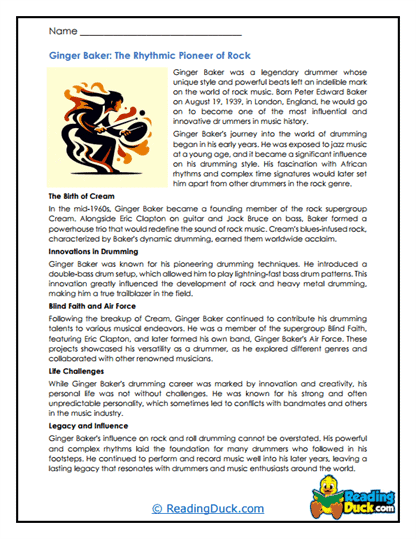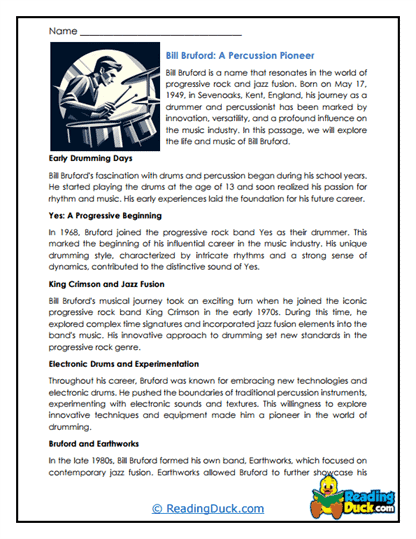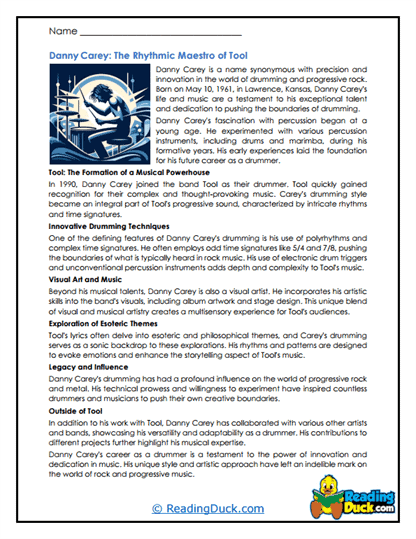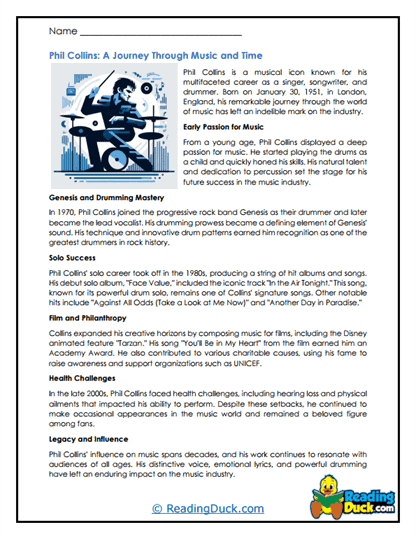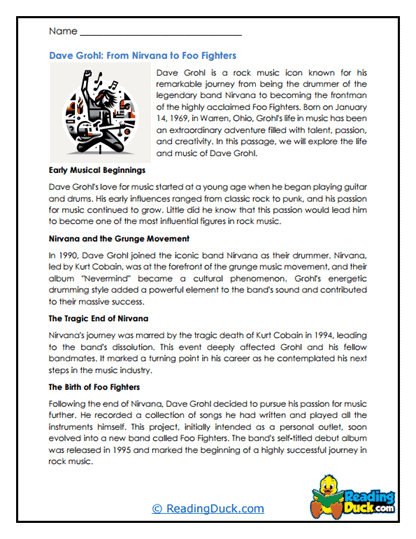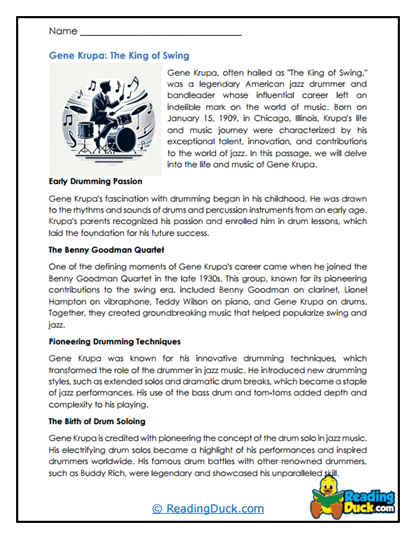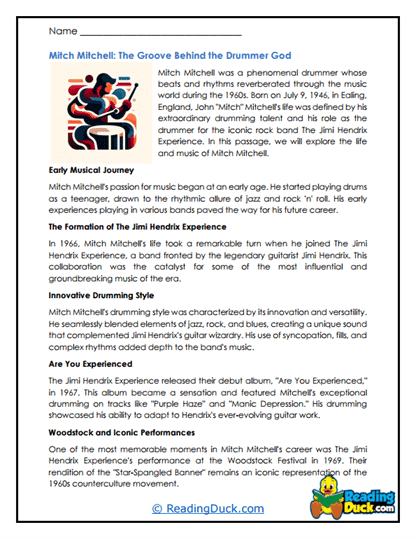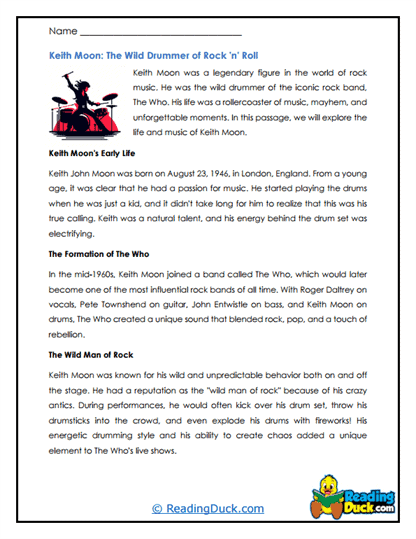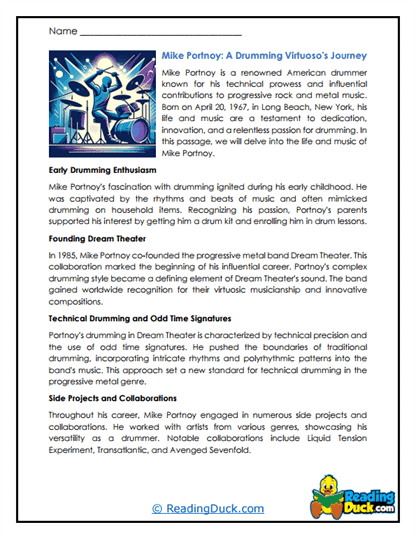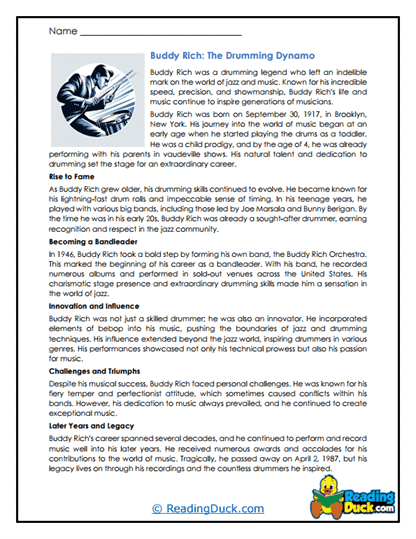Drummers Worksheets
About Our Drummers Worksheets
Our Drummers worksheets offer an engaging and comprehensive exploration of some of the most influential drummers in music history. Drummers are the heartbeat of a band, providing rhythm, energy, and dynamics that shape the sound of the music. This collection delves into the lives, styles, and legacies of legendary drummers across various genres, from jazz and rock to funk and pop. These worksheets are designed to help students appreciate the technical skill, creativity, and cultural impact that drummers bring to the music world.
Each topic in our Drummers collection contains several worksheet sets, each crafted to build students' understanding and connection to the material. These sets include:
- Multiple Choice Questions: These questions test students' comprehension of the reading passages, focusing on key facts about the drummer's life, career, and contributions to music. This format helps reinforce students’ understanding and encourages them to engage with the material in detail.
- Short Answer Questions: This format challenges students to reflect on what they’ve learned by writing their responses in their own words. These questions encourage deeper thinking and help students articulate their thoughts and insights about the drummer's influence and style.
- Open-Ended Questions: These questions invite students to explore their personal responses to the material, asking them to express opinions, preferences, or interpretations related to the drummer's music and legacy. This format fosters critical thinking and allows students to connect with the content on a more personal level.
Each worksheet set is designed to assess students’ understanding while enhancing their engagement with the topic. An answer key is provided for every question sheet, making it easy for educators to review and evaluate students’ progress. All worksheets are available as PDF files, which can be easily viewed electronically, downloaded, and printed.
The Beat of the Band: Exploring the Legacy of Iconic Drummers
Drummers are the driving force behind a band’s sound, setting the tempo, maintaining the groove, and adding dynamic intensity to the music. When introducing students to the world of drummers, it’s essential to highlight how these musicians have shaped the sound of various genres and left an indelible mark on music history. From the syncopated rhythms of jazz to the hard-hitting beats of rock, drummers bring a unique energy that is both heard and felt.
Key Aspects of Drummers:
- The Role of the Drummer in a Band: Drummers are often referred to as the backbone of a band. They provide the rhythmic foundation that supports the other instruments and vocals, ensuring that the music stays cohesive and engaging. Students should understand how the drummer’s role is crucial to maintaining the structure and flow of a song, as well as how different drumming styles can dramatically alter the feel of a piece.
- Influential Drummers Across Genres: Each genre of music has its iconic drummers who have pioneered new techniques and styles. In jazz, drummers like Buddy Rich and Max Roach brought incredible technical skill and improvisational flair to the instrument. In rock, drummers such as John Bonham of Led Zeppelin and Neil Peart of Rush set the standard for power and precision. In funk, Clyde Stubblefield’s work with James Brown defined the genre’s groove-heavy sound. Exploring these drummers’ contributions helps students appreciate the diversity and evolution of drumming.
- The Evolution of Drumming Techniques: Drumming has evolved significantly over the years, with new techniques and technologies expanding what drummers can achieve. Techniques like double bass drumming, intricate stick work, and the use of electronic drum pads have allowed drummers to push the boundaries of their instrument. Students should learn about these innovations and how they have influenced the sound of modern music.
- Cultural Impact and Legacy: Beyond their technical skills, drummers have had a profound cultural impact. They have influenced countless musicians and shaped the sound and direction of entire genres. For example, Ringo Starr’s work with The Beatles helped popularize the rock ‘n’ roll beat, while Tony Williams’ pioneering work in jazz fusion redefined what was possible on the drum kit. Recognizing the cultural significance of these drummers helps students see the broader impact of music on society.
- Connecting Music and Emotion: Drummers play a crucial role in conveying emotion through music. The intensity, tempo, and dynamics of drumming can evoke a wide range of emotions, from excitement and joy to tension and melancholy. Students should explore how drummers use their instruments to create emotional responses in listeners, deepening their appreciation for the expressive power of music.
By exploring these key aspects of drummers and their contributions to music, students can develop a well-rounded understanding of the art of drumming. They will learn to appreciate the technical skills, creativity, and cultural impact that drummers bring to the music world. This knowledge not only enhances their musical education but also fosters a deeper connection to the music they listen to and play.
The Importance of Music Education
Music education is essential for students of all ages because it nurtures creativity, enhances cognitive development, and provides a means of emotional expression. Learning about music, whether through playing an instrument, understanding music theory, or studying influential musicians, helps students develop skills that are transferable to other areas of life. It encourages discipline, perseverance, and teamwork, while also improving memory and problem-solving abilities.
Moreover, music education allows students to explore their own creativity and connect with others on a deeper level. It fosters an appreciation for different cultures and histories, as music often reflects the values and experiences of diverse communities. By studying music and the artists who create it, students gain a greater understanding of the world around them, enriching their personal and academic development.
Integrating These Worksheets in a Curriculum
To effectively incorporate our Drummers worksheets into your curriculum, here are some tips for teachers and parents:
- Thematic Lessons: Create themed lessons around specific genres or periods in music history. For example, explore the evolution of rock drumming from the 1960s to the present, focusing on how drummers like Keith Moon, Phil Collins, and Dave Grohl have influenced the genre.
- Comparative Analysis: Encourage students to compare and contrast the styles and techniques of different drummers. This could involve examining how jazz drumming differs from rock drumming, or how various drummers have interpreted similar rhythmic patterns in unique ways.
- Interactive Listening Sessions: Pair the worksheets with listening sessions where students can hear the drummers in action. Use audio or video recordings to showcase the musicians discussed in the worksheets, helping students connect the theoretical aspects of their studies with the actual sound and feel of the music.
- Creative Projects: Assign creative projects where students can create their own drum patterns, analyze the drumming in their favorite songs, or create a presentation on their favorite drummer. These hands-on activities allow students to apply what they’ve learned in a practical and engaging way.
- Cross-Disciplinary Connections: Link the study of drummers with other subjects such as history, social studies, or physical education. For example, discuss how the social and cultural context of the 1970s influenced the rise of punk drumming, or explore the physical endurance required by drummers in live performances.
- Group Discussions: Use the open-ended questions in the worksheets as prompts for group discussions. Encourage students to share their thoughts on the music, the musicians, and the cultural impact of the drummers they are studying. These discussions can help students develop critical thinking skills and learn to articulate their opinions effectively.
- Assessment and Feedback: Use the multiple choice and short answer questions to assess students’ understanding of the material. Provide personalized feedback that highlights their strengths and areas for improvement, helping them grow as both students and music enthusiasts.
By using these strategies, teachers and parents can help students gain a deeper understanding of drumming, develop critical listening skills, and foster a lifelong appreciation for the art of music. The Drummers worksheets are a valuable resource that can be integrated into a variety of educational settings, making music history and theory accessible and engaging for all students. Through consistent practice and exploration, students will not only learn about the great drummers of the past and present but also develop a greater appreciation for the art of music itself.
